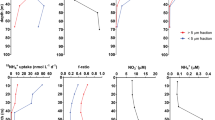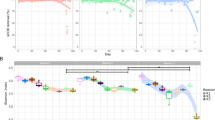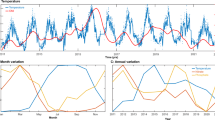Abstract
In microbial mat communities of Yellowstone hot springs, ribosomal RNA (rRNA) sequence diversity patterns indicate the presence of closely related bacterial populations along environmental gradients of temperature and light. To identify the functional bases for adaptation, we sequenced the genomes of two cyanobacterial (Synechococcus OS-A and OS-B′) isolates representing ecologically distinct populations that dominate at different temperatures and are major primary producers in the mat. There was a marked lack of conserved large-scale gene order between the two Synechococcus genomes, indicative of extensive genomic rearrangements. Comparative genomic analyses showed that the isolates shared a large fraction of their gene content at high identity, yet, differences in phosphate and nitrogen utilization pathways indicated that they have adapted differentially to nutrient fluxes, possibly by the acquisition of genes by lateral gene transfer or their loss in certain populations. Comparisons of the Synechococcus genomes to metagenomic sequences derived from mats where these Synechococcus stains were originally isolated, revealed new facets of microbial diversity. First, Synechococcus populations at the lower temperature regions of the mat showed greater sequence diversity than those at high temperatures, consistent with a greater number of ecologically distinct populations at the lower temperature. Second, we found evidence of a specialized population that is apparently very closely related to Synechococcus OS-B′, but contains genes that function in the uptake of reduced ferrous iron. In situ expression studies demonstrated that these genes are differentially expressed over the diel cycle, with highest expression when the mats are anoxic and iron may be in the reduced state. Genomic information from these mat-specific isolates and metagenomic information can be coupled to detect naturally occurring populations that are associated with different functionalities, not always represented by isolates, but which may nevertheless be important for niche partitioning and the establishment of microbial community structure.
Similar content being viewed by others
Log in or create a free account to read this content
Gain free access to this article, as well as selected content from this journal and more on nature.com
or
References
Allewalt JP, Bateson MM, Revsbech NP, Slack K, Ward DM . (2006). Effect of temperature and light on growth of and photosynthesis by Synechococcus isolates typical of those predominating in the octopus spring microbial mat community of Yellowstone National Park. Appl Environ Microbiol 72: 544–550.
Andrews SC, Robinson AK, Rodriguez-Quinones F . (2003). Bacterial iron homeostasis. FEMS Microbiol Rev 27: 215–237.
Bateman A, Coin L, Durbin R, Finn RD, Hollich V, Griffiths-Jones S et al. (2004). The Pfam protein families database. Nucleic Acids Res 32: D138–D141.
Bateson MM, Ward DM . (1988). Photoexcretion and consumption of glycolate in a hot spring cyanobacterial mat. Appl Environ Microbiol 54: 1738–1743.
Bennett PM . (2004). Genome plasticity: insertion sequence elements, transposons and integrons, and DNA rearrangement. Methods Mol Biol 266: 71–113.
Bentley SD, Parkhill J . (2004). Comparative genomic structure of prokaryotes. Annu Rev Genet 38: 771–792.
Bhaya D . (2004). Light matters: phototaxis and signal transduction in unicellular cyanobacteria. Mol Microbiol 53: 745–754.
Brock TD . (1978). Thermophilic Microorganisms and Life at High Temperatures. Springer Verlag: Berlin.
Claros MG, von Heijne G . (1994). TopPred II: an improved software for membrane protein structure predictions. Comput Appl Biosci 10: 685–686.
Cohan F . (2006). Towards a conceptual and operational union of bacterial systematics, ecology, and evolution. Philos Trans Roy Soc B 361: 1985–2006.
Cohan FM, Perry EB . (2007). A systematics for discovering the fundamental units of bacterial diversity. Curr Biol 17: R373–R386.
Delcher AL, Phillippy A, Carlton J, Salzberg SL . (2002). Fast algorithms for large-scale genome alignment and comparison. Nucleic Acids Res 30: 2478–2483.
Dyhrman ST, Chappell PD, Haley ST, Moffett JW, Orchard ED, Waterbury JB et al. (2006). Phosphonate utilization by the globally important marine diazotroph Trichodesmium. Nature 439: 68–71.
Ferris MJ, Ward DM . (1997). Seasonal distributions of dominant 16S rRNA-defined populations in a hot spring microbial mat examined by denaturing gradient gel electrophoresis. Appl Environ Microbiol 63: 1375–1381.
Haft DH, Selengut JD, White O . (2003). The TIGRFAMs database of protein families. Nucleic Acids Res 31: 371–373.
Heidelberg JF, Seshadri R, Haveman SA, Hemme CL, Paulsen IT, Kolonay JF et al. (2004). The genome sequence of the anaerobic, sulfate-reducing bacterium Desulfovibrio vulgaris Hildenborough. Nat Biotechnol 22: 554–559.
Hoehler TM, Bebout BM, Des Marais DJ . (2001). The role of microbial mats in the production of reduced gases on the early Earth. Nature 412: 324.
Huang J, Su Z, Xu Y . (2005). The evolution of microbial phosphonate degradative pathways. J Mol Evol 61: 682–690.
Kilian O, Steunou AS, Fazeli F, Bailey S, Bhaya D, Grossman AR . (2007). Responses of a thermophilic Synechococcus isolate from the microbial mat of Octopus Spring to light. Appl Environ Microbiol 73: 4268–4278.
Konopka A . (1992). Accumulation and utilization of polysaccharide by hot-spring phototrophs during a light–dark transition. FEMS Microbiol Lett 102: 27–32.
Konstantinidis KT, Tiedje JM . (2005). Genomic insights that advance the species definition for prokaryotes. Proc Natl Acad Sci USA 102: 2567–2572.
Mackerras AH, Youens BN, Wier RC, Smith GD . (1990). Is cyanophycin involved in the integration of nitrogen and carbon metabolism in the cyanobacteria Anabaena cylindrica and Gleothece grown on light/dark cycles? J Gen Microbiol 136: 2049–2056.
Nold SC, Ward DM . (1996). Photosynthate partitioning and fermentation in hot spring microbial mat communities. Appl Environ Microbiol 62: 4598–4607.
Nübel U, Bateson MM, Vandieken V, Wieland A, Kuhl M, Ward DM . (2002). Microscopic examination of distribution and phenotypic properties of phylogenetically diverse Chloroflexaceae-related bacteria in hot spring microbial mats. Appl Environ Microbiol 68: 4593–4603.
Paerl HW, Pinckney JL, Steppe TF . (2000). Cyanobacterial-bacterial mat consortia: examining the functional unit of microbial survival and growth in extreme environments. Environ Microbiol 2: 11–26.
Palenik B, Brahamsha B, Larimer FW, Land M, Hauser L, Chain P et al. (2003). The genome of a motile marine Synechococcus. Nature 424: 1037–1042.
Papke RT, Ramsing NB, Bateson MM, Ward DM . (2003). Geographical isolation in hot spring cyanobacteria. Environ Microbiol 5: 650–659.
Parkhill J, Sebaihia M, Preston A, Murphy LD, Thomson N, Harris DE et al. (2003). Comparative analysis of the genome sequences of Bordetella pertussis, Bordetella parapertussis and Bordetella bronchiseptica. Nat Genet 35: 32–40.
Peterson JD, Umayam LA, Dickinson T, Hickey EK, White O . (2001). The comprehensive microbial resource. Nucleic Acids Res 29: 123–125.
Ramsing NB, Ferris MJ, Ward DM . (2000). Highly ordered vertical structure of Synechococcus populations within the one-millimeter-thick photic zone of a hot spring cyanobacterial mat. Appl Environ Microbiol 66: 1038–1049.
Ramsing NB, Ferris MJ, Ward DM . (1997). Light-induced motility of thermophilic Synechococcus isolates from Octopus Spring, Yellowstone National Park. Appl Environ Microbiol 63: 2347–2354.
Rocap G, Larimer FW, Lamerdin J, Malfatti S, Chain P, Ahlgren NA et al. (2003). Genome divergence in two Prochlorococcus ecotypes reflects oceanic niche differentiation. Nature 424: 1042–1047.
Simon RD . (1987). Inclusion bodies in the cyanobacteria: cyanophycin, polyphosphate, polyhedral bodies. In: Fay P, Van Baalen C (eds). The Cyanobacteria. Elsevier Science Publishers B.V.:Amsterdam, pp 199–225.
Stal LJ . (2000). Cyanobacterial mats and stromatolites. In: Potts M, Whitton BA (eds). The Ecology of Cyanobacteria. Kluwer Academic Publishers: Norwell, MA, pp 61–120.
Steunou AS, Bhaya D, Bateson MM, Melendrez MC, Ward DM, Brecht E et al. (2006). In situ analysis of nitrogen fixation and metabolic switching in unicellular thermophilic cyanobacteria inhabiting hot spring microbial mats. Proc Natl Acad Sci USA 103: 2398–2403.
Stevens SE, Poane DAM . (1981). Accumulation of cyanophycin granules as a result of phosphate limitation in Agmenellum quadruplicatum. Plant Physiol 67: 716–719.
Teske A, Stahl D . (2002). Microbial mats and biofilms: evolution, structure, and function of fixed microbial communities. In: Staley JT, Reysenbach AL (eds). Biodiversity of Microbial Life. Wiley-Liss: New York, pp 49–100.
Tringe SG, von Mering C, Kobayashi A, Salamov AA, Chen K, Chang HW et al. (2005). Comparative metagenomics of microbial communities. Science 308: 554–557.
Ward DM . (1998). A natural species concept for prokaryotes. Curr Opin Microbiol 1: 271–277.
Ward DM, Bateson MM, Ferris MJ, Kuhl M, Wieland A, Koeppel A et al. (2006). Cyanobacterial ecotypes in the microbial mat community of Mushroom Spring (Yellowstone National Park, Wyoming) as species-like units linking microbial community composition, structure and function. Philos Trans R Soc Lond B Biol Sci 361: 1997–2008.
Ward DM, Castenholz RW . (2000). Cyanobacteria in geothermal habitats. In: Whitton BA, Potts M (eds). The Ecology of Cyanobacteria. Kluwer Academic Publishers: Norwell, MA, pp 37–59.
Ward DM, Cohan FM . (2005). Microbial diversity in hot spring cyanobacterial mats: pattern and prediction. In: Inskeep B, McDermott T (eds). Geothermal Biology and Geochemistry in Yellowstone National Park. Thermal Biology Institute, Montana State University: Bozeman, MT, pp 185–201.
Ward DM, Cohan FM, Heidelberg J, Bhaya D, Kuhl M, Grossman AR . (2007). Genomics, environmental genomics and the issue of microbial species. Heredity (6 June 2007; E-pub ahead of print).
Ward DM, Ferris MJ, Nold SC, Bateson MM . (1998). A natural view of microbial biodiversity within hot spring cyanobacterial mat communities. Microbiol Mol Biol Rev 62: 1353–1370.
Ward DM, Panke S, Kloppel KD, Christ R, Fredrickson H . (1994). Complex polar lipids of a hot spring cyanobacterial mat and its cultivated inhabitants. Appl Environ Microbiol 60: 3358–3367.
Ward DM, Weller R, Bateson MM . (1990). 16S rRNA sequences reveal numerous uncultured microorganisms in a natural community. Nature 345: 63–65.
Ward DM . (2006). A macrobiological perspective on microbial species. Microbe 1: 269–278.
Wion D, Casadesus J . (2006). N6-methyl-adenine: an epigenetic signal for DNA–protein interactions. Nat Rev Microbiol 4: 183–192.
Acknowledgements
The research was funded by the Frontiers in Integrative Biology (FIBR) program at NSF (Grant EF-0328698). Natalia Khuri acknowledges a NSF-ROA Grant. The sequence of the chromosome of Synechococcus OS-A and Synechococcus OS-B′ have been deposited at GenBank (CP000239 and CP000240). Sequences of clones covering the feo region (EU189023); the urease region (EU189024 and EU189025) and metagenome sequences (Project IDs 20717, 20719, 20721,20723, 20725 and 20727) are also available at Genbank. Updates and further details on this project will be maintained at the following web sites: http://landresources.montana.edu/FIBR/ and http://fumarole.stanford.edu. We thank the Yellowstone National Park authorities for their excellent support. We also acknowledge the discussions with members of the Annual FIBR workshops held at the University of Montana, Bozeman.
Author information
Authors and Affiliations
Corresponding author
Additional information
Supplementary Information accompanies the paper on The ISME Journal website (http://www.nature.com/ismej)
Supplementary information
Rights and permissions
About this article
Cite this article
Bhaya, D., Grossman, A., Steunou, AS. et al. Population level functional diversity in a microbial community revealed by comparative genomic and metagenomic analyses. ISME J 1, 703–713 (2007). https://doi.org/10.1038/ismej.2007.46
Received:
Revised:
Accepted:
Published:
Issue date:
DOI: https://doi.org/10.1038/ismej.2007.46
Keywords
This article is cited by
-
Genome-scale identification and comparative analysis of transcription factors in thermophilic cyanobacteria
BMC Genomics (2024)
-
Acclimation of the photosynthetic apparatus to low light in a thermophilic Synechococcus sp. strain
Photosynthesis Research (2022)
-
Environment Shapes the Intra-species Diversity of Bacillus subtilis Isolates
Microbial Ecology (2020)
-
Ecological Divergence with Gene Flow in a Thermophilic Cyanobacterium
Microbial Ecology (2019)
-
Genome analysis of the freshwater planktonic Vulcanococcus limneticus sp. nov. reveals horizontal transfer of nitrogenase operon and alternative pathways of nitrogen utilization
BMC Genomics (2018)



